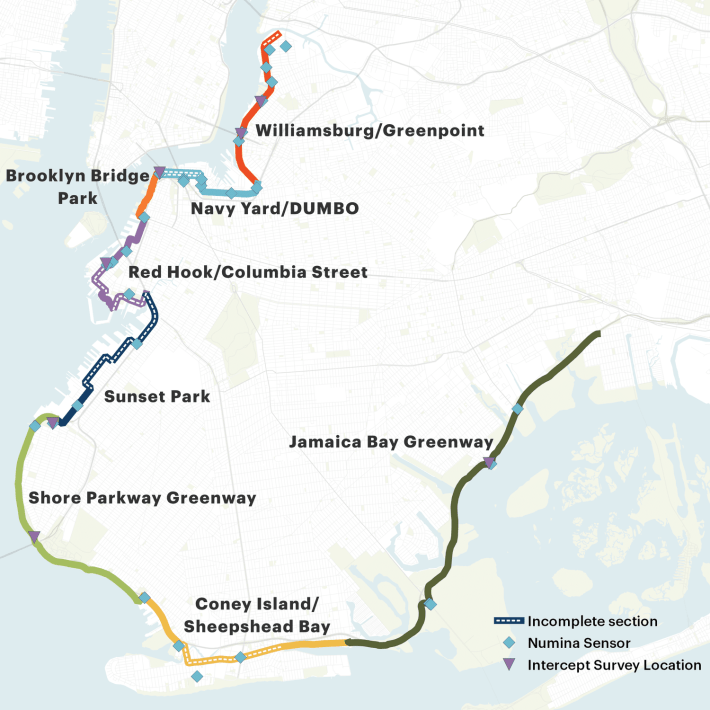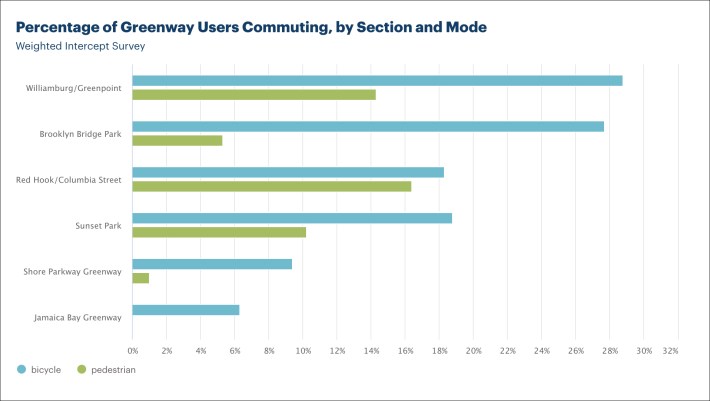Thousands of cyclists rely on the Brooklyn waterfront greenway to commute to work each day, according to a new study that makes the case that the bike and pedestrian paths are key transportation corridors.
Nearly one-quarter of bike trips and one-in-eight pedestrian journeys on the borough's coastal greenways were for getting to or from work, according to the study by the Brooklyn Greenway Initiative, Regional Plan Association, the Department of Transportation and data collection company Numina.
That represents between 3,000 and 7,000 people per day, rivaling bike counts on the East River bridges like the Brooklyn or Manhattan bridges. The numbers show why city officials should treat the popular lanes as more than mere recreational paths, according to advocates behind the report.
"We’re not just speculating now based on our personal observations, we actually know this to be true," said BGI Executive Director Hunter Armstrong.
Another sign of the greenway's essential role in transportation: Usage doesn't drop significantly during bad weather or the colder months, with just 30 percent fewer pedestrians and 42 percent fewer cyclists during the "off-months," an indications that people who use greenways rely on them year-round.
"That is showing how many people are relying on this either for commuting, their delivery work, or some form of recreation," said Armstrong.

However, the city struggles to maintain its vast network of greenways across te five boroughs. Officials often route cyclists onto dangerous detours shared with car traffic while the greenways undergo repairs, a problem Streetsblog has documented extensively.
The Parks Department, which manages most of the city's greenways, has repeatedly closed off uptown sections of the Hudson River Greenway — the nation's busiest bike lane — while sending bike riders onto streets without protections from automobiles. The most recent closure of the Cherry Walk is slated to last at least six months.
The 29-mile Brooklyn waterfront route from the top of Greenpoint to Jamaica Bay still has several gaps. Filling those while expanding the busier stretches will be key to the city's sustainable transportation system, according to advocates.
The hot spots for greenway commutes are near job centers like Williamsburg and Greenpoint, were 29 percent of cyclists used the protected paths — largely the two-way Kent Avenue bike lane – to get to and from work, the study found.
Just one block of Kent Avenue between N. Eighth and N. Ninth streets peaked at 157,020 riders in July of this year, according to DOT's counts — about 211 per hour.
Advocates have urged the city to update the Bloomberg-era bike lane to make room for the increased demand.
"It was cutting edge in 2010, but it’s still exactly as it was," said Jon Orcutt, the director of advocacy at Bike New York, who worked DOT during the previous two mayoral administrations. "You didn’t have anywhere near the bike traffic on Kent Avenue and Flushing Avenue 10 years ago, but now we’ve created those facilities and created that intensity of use."

On the flip side, sections of greenway in southern Brooklyn could carry more riders if they connected better to the street grid, such as the Jamaica Bay Greenway, which has few access points around the Belt Parkway or safe connections to transit hubs like the L train terminus in Canarsie, said Orcutt.
"They’re these kind of stranded resources that have been chopped off or eclipsed or unexploited from a point of view of generating transportation trips, but the potential’s all there," he said.
More than one-in-five greenway trips — 21 percent — do involve users connecting to transit, mostly via the subway or the NYC Ferry, especially in DUMBO, which has two ferry stops and is close to several subway stops.
Some greenway users also flocked to the paths to meet with friends of family, especially at the Shore Parkway and Brooklyn Bridge Park, making up 8.6 percent and 6 percent of those riders, respectively.
Researchers placed sensors at 32 locations across the greenway to count how many people were on it and which mode of transportation they used. The study also included interviews with more than 1,000 greenway users, along with a survey of residents from ZIP codes along the paths.
Mayor Adams vowed last year to add 40 miles of greenway across the city, including upgrades to the historic malls along Eastern Parkway and the deteriorating Ocean Parkway in Brooklyn. The city has yet to provide a schedule or price tag to back up the mayor's pledge, however.
Armstrong said the new data can help advocates better push for city funding to complete sections of greenways, such as the gaps in Red Hook and Sunset Park, or building out at-capacity legs in north Brooklyn.
"We certainly can use the counts that we’ve gotten and the feedback we’ve gotten… as ammunition to advocate for completion of the greenway network," he said.






